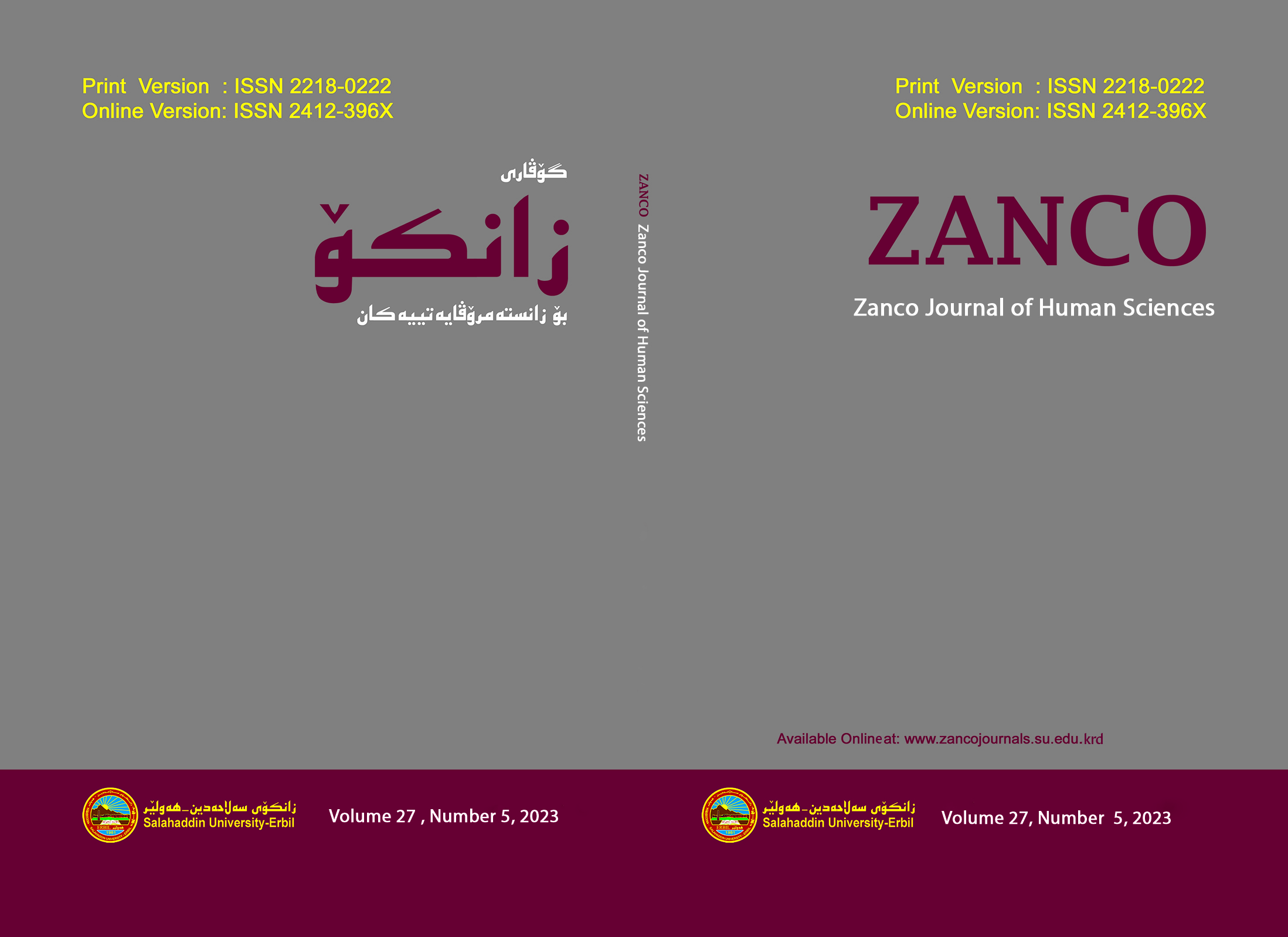Relationship Between Personality Traits, and Desired Leadership Styles, their Impact on Lecturers in Classrooms Management at Salahaddin University, Erbil – Kurdistan Regional Government
DOI:
https://doi.org/10.21271/zjhs.27.5.20Keywords:
Personality traits, leadership, Management, lecturers, classroomAbstract
This study explores the lecturers’ personality traits and leadership styles at Salahaddin University in Iraqi Kurdistan. It examined the relationship between lecturers’ personality traits and their desired leadership styles in the management of the classrooms. The quantitative method was used for this research. With the help of IT members at Salahaddin University, questionnaire via Google Forms electronically were sent out to different participants. Lecturers from different colleges at Salahaddin University were randomly selected and a total of 188 lecturers out of total of 2480 lecturers participated in this study. SPSS statistical computer package was used to analyze the findings. Moreover, multi-regression analysis tests are used to see the predictability of dependent variables. The findings indicate that there is a positive correlation between variables. Thus, the results of the multi-regression analysis show both personality traits and leadership styles can be predicted by each other, and also play a role in shaping the other one. But the personality traits had a stronger impact on leadership styles. The findings were discussed and the implication and recommendations are put forward. It is recommended that further research and attention need to be given to these topics.
References
• Alkahtani, H. A., Jarad, A. I., Sulaiman, M., & Nikbin, D. (2011). THE IMPACT OF PERSONALITY AND LEADERSHIP STYLES ON LEADING CHANGE CAPABILITY OF MALAYSIAN MANAGERS. Australian Journal of Business and Management Research. Vol.1 No.2.
• Amponsah, O. M., & and Asamani, l. (2016). PERSONALITY TRAITS OF TEACHERS AND DESIRED LEADERSHIP STYLES. British Journal of Psychology Research. Vol.3, No.5, pp.1-15, December 2015.
• Bhamani, M. (2012). The difference between Leadership and Management School of thought. Athabasca University, Centre for Innovative Management.
• Bozgeyikli, H. (2017). Big Five Personality Traits as The Predictor of Teachers’ Organizational Psychological Capital. Journal of Education and Practice. SSN 2222-1735 (Paper) ISSN 2222-288X (Online) Vol.8, No.18.
• Bozkuş, K. (2021). A Systematic Review of Studies on Classroom Management from 1980 to 2019. International Electronic Journal of Elementary Education. March 2021, Volume 13, Issue 4, 433-441, 10.26822/iejee.2021.202.
• Bozionelos, N. & Leung, S.L. (2003). Five-factor model traits and the prototypical image of the effective leader in the Confucian culture. Employee Relations, Vol. 26 No. 1, 2004 pp. 62-71 q Emerald Group Publishing Limited 0142-5455 DOI 10.1108/01425450410506904.
• Casey, A. Z., Lozenski, D. B. & McManimon, K. S. (2013) From neoliberal policy to neoliberal pedagogy: Racializing and historicizing classroom management. Journal of Pedagogy - Pedagogický časopis, JoP 4 (1): 36 – 58, DOI 10.2478/jped-2013-0003.
• Chambers, S., Henson, R., & Sienty, S. (2001). Personality types and teaching efficacy as predictors of classroom control orientation in beginning teachers. Presented at the Annual Meeting of the Southwest Educational Research Association, New Orleans, LA.
• Chandra, R. (2015). Classroom Management for Effective Teaching. International Journal of Education and Psychological Research (IJEPR), Volume 4, Issue 4.
• Creative Property of The Vision Council, available at: https://www.bumc.bu.edu/facdev-medicine/files/2010/10/Leadership-Matrix-Self-Assessment-Questionnaire.pdf (accessed at 02 of July 2022).
• Etheridge, T. (2010). Assertive Discipline and Its Impact on Disruptive Behavior. Dissertation completed at Capella University.1-118. (Publication No. AAT 3409180)
• Farsani, E. M., Azadi, A., Farsani, A. F., & Aroufzad, S. (2013). Relationship between leadership styles and personality traits among woman physical education teachers. European Journal of Sports and Exercise Science. 2 (1):17-21 (http://scholarsresearchlibrary.com/archive.html)
• Gao, M., & Liu, Q. (2013). Personality Traits of Effective Teachers Represented in the Narratives of American and Chinese Preservice Teachers: A Cross-Cultural Comparison. International Journal of Humanities and Social Science. Vol. 3 No. 2. The Special Issue on Contemporary Research in Behavioral and Social Science © Centre for Promoting Ideas, USA.
• Gardner, W. J., (2010). The Tasks of Leadership: A Literature-Bassed Assessment In: Perry, L. J., ed. 2010.The Jossey-Bass Reader on Nonprofit and Public Leadership. San Francisco: Jossey-bass. Ch. 2.
• Hair, J.F, Black, W.C, Babin, B.J, Anderson, R.E (2010): Multivariate Data Analysis. Pearson. 7th ed.
• Hair, J. F. JR., Bush, P. R., Ortinuau, J. D., (2002). Marketing Research Within a Changing Information Environment. London: The McGraw-Hill Companies.
• Hartog, N. D., & Koopman, L. P. (2011). “Leadership in Organizations”. Handbook of Industrial, work & Organizational Psychology. SAGE Publication.
• Hassan, S. (2015a). Change in scores of Hofstede’s Cultural Dimensions in Iraq by using Individual Level of Measures, a case study of Iraqi Kurds. European Journal of Business & Management. Vol.7, No.9, pp. 212- 225.
• Hassan, S. (2015b). THE INFLUENCE OF NATIONAL CULTURE ON INTERNATIONAL MARKETING & CONSUMER BEHAVIOR IN IRAQI KURDISTAN, USING HOFSTEDE’S MODEL AT INDIVIDUAL LEVEL. British Journal of Marketing Studies, Published by European Centre for Research Training and Development UK. Vol.3, No.8, pp.50-78.
• Hodgson, D. (2012). Personality in the Classroom. Motivating and inspiring every teacher and student. Crown House Publishing Limited www.crownhouse.co.uk.
• Hofstede, G., Hofstede, G.J., & Minkov, M. (2010). Culture and Organization – Software of the Mind: Intercultural Cooperation and its Importance for Survival. 3 rd Ed. United States: The McGraw-Hill.
• Hoshino, Y., Asad, S., & Hassan, H. (2016). Determinants of Leadership Style in Big Five Personality Dimensions. Universal Journal of Management. 4(4): 161-179, http://www.hrpub.org DOI: 10.13189/ujm.2016.040402.
• Huczynski, A. A., & Buchanan, A. D. (2007). Organizational Behaviour. Six Edition. England: FT Prentice Hall.
• Hughes, L. R., Ginnett, C. R., & Curphy, J. G. (2012). Leadership, Enhancing the Lessons of Experience. Seven Edition. America: McGraw-Hill/Irwin.
• Ibad, F. (2018). Personality and Ability Traits of Teachers: Student Perceptions. Journal of Education and Educational Development. Vol. 5 No. 2.
• IBM SPSS Statistics Base 19. (2010). Copyright SPSS Inc.
• Isaksen, S., & Tidd, J. (2006). Meeting the Innovation Challenge: Leadership for Transformation and Growth. England: Published by John Wiley & Sons Ltd.
• Kaleem, A., & Salahuddin, T. (2007). Personality Traits of an Ideal Teacher: A Case of COMSATS Institute of Information Technology, Pakistan. Bulletin of Education & Research. Vol. 29, No. 1, pp. 33-46
• Kothari, P. T., & Pingle, S. S. (2015). PERSONALITY TRAITS AND TEACHING STYLE OF MANAGEMENT TEACHERS: AN EMPIRICAL STUDY. The Journal - Contemporary Management Research. Vol.9, Issue No. 2, 16 - 38.
• Landau, S., & Everitt, S. B., (2004). A Handbook of Statistical Analyses using SPSS. London: Chapman & Hall/CRC Press LLC.
• Makovec, D. (2018). THE TEACHER’S ROLE AND PROFESSIONAL DEVELOPMENT. (IJCRSEE) International Journal of Cognitive Research in Science, Engineering and Education. Vol. 6, No. 2, doi:10.5937/ijcrsee1802033M.
• Mullins, J. L. (2005). Management and Organizational Behaviour. Seven Edition. England: FT, Prentice Hall.
• Oliver, M. R. & Reschly, J. D. (2007). Effective Classroom Management: Teacher Preparation and Professional Development. TQ Connection Issue Paper on Improving Student Outcomes In General and Special Education, Washington, www.tqsource.org (accessed at 2 July 2022).
• Retnawati, H, A. I., Kistoro, H., Kartowagiran, B., & Istiyono, E. (2021). Effective teachers’ personality in strengthening character education. International Journal of Evaluation and Research in Education (IJERE). Vol. 10, No. 2, pp. 512~521 ISSN: 2252-8822, DOI: 10.11591/ijere.v10i2.21629.
• Ristic, J., & Simic, R. M. (2017). The Relationship Between Personality Traits and Managers` Leadership Styles. European Journal of Social Sciences Education and Research. Vol.11 Nr. 2.
• Robbins, S.P., & Judge, T.A. (2013). Organizational Behavior. Fifteenth Edition. England: Pearson Education limited.
• Robbins, S.P., & Judge, T.A. (2011). Organizational Behavior. Fourth Edition. England: Pearson Education limited.
• Rollinson, D., Broadfield, A., & Edward, J. D. (1998). Organizational Behaviour & Analysis, An Integrated Approach. England: Addison-Wesley.
• Robbins, S.P. and Coulter, M.K. (2009) Management. 10th Edition, Pearson Education, Inc., Upper Saddle River.
• Peace Corps (N-D). Classroom Management, Idea Book. Office of Overseas Programming and Training Support, Information Collection and Exchange. Abridged Dewey Decimal Classification (DDC) Number: 371.102, Washington, Publication Number. M0088.
• Salleh, R., Idrus, H., & Harun, H. (2013). Desirable Personality Traits of University Lecturers from the Technical Students’ Perspectives. Proceeding of the Research in Engineering Education Symposium. Kuala Lumpur (REES).
• Sinn, J., (N.D). SPSS Guide, Correlation & Regression. Winthrop University.
• Smithikrai, C. (2007). Personality Traits and Job Success: An investigation in a Thai sample. International Journal of Selection and Assessment, Volume 15 Number 1, Blackwell Publishing Ltd.
• SPSS, Chapter 4: Regression Analysis, 2010
• SPSS, Chapter 4: Regression Analysis, 2022
• Talbot, C. (2008). Measuring Public Value: A competing values approach, A paper for The Work Foundation. Herbert Simon Institute. Manchester Business School
• Tavakol, M. & Dennick, R. (2011). Making sense of Cronbach’s alpha. International Journal of Medical Education. 2:53-55.
• The Big Five Personality Test, from personality-testing.info courtesy ipip.ori.org. (accessed at 02 July, 2022).
• Van Wart, M. (2010). Public-Sector Leadership Theory: An Assessment: A Literature; Bassed Assessment In: Perry, L. J., ed. 2010.The Jossey-Bass Reader on Nonprofit and Public Leadership. San Francisco: Jossey-bass. Ch. 6.
Downloads
Published
How to Cite
Issue
Section
License
Copyright (c) 2023 Sardar Hassan Khal Hamza

This work is licensed under a Creative Commons Attribution-NonCommercial-ShareAlike 4.0 International License.
Except where otherwise noted, content on this site is licenced
under a Creative Commons Attribution License 4.0 (CC BY- 4.0)










